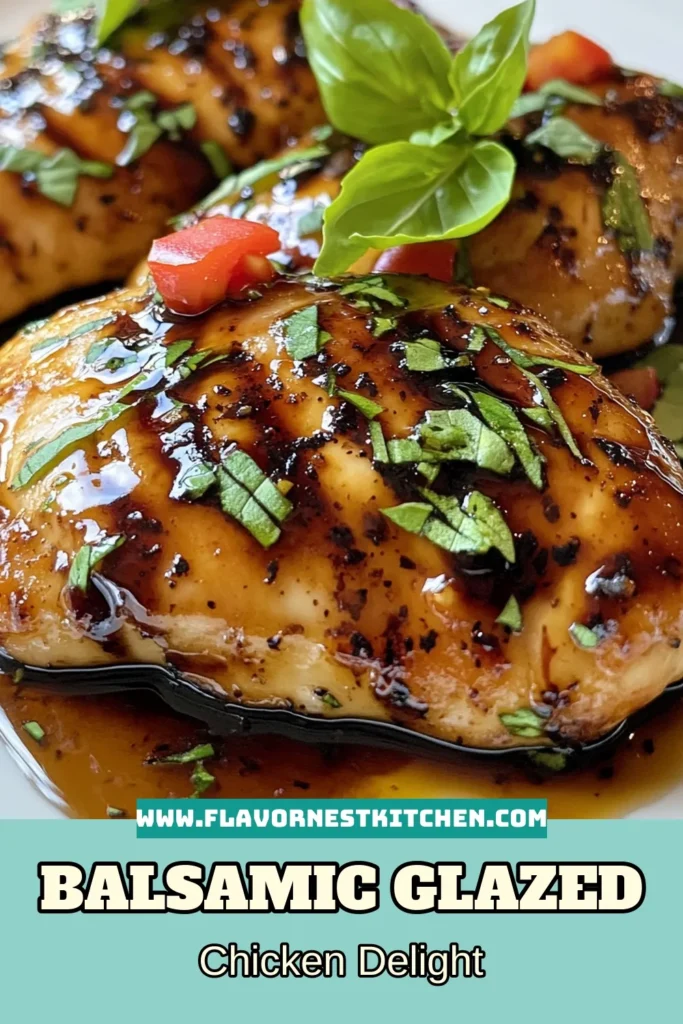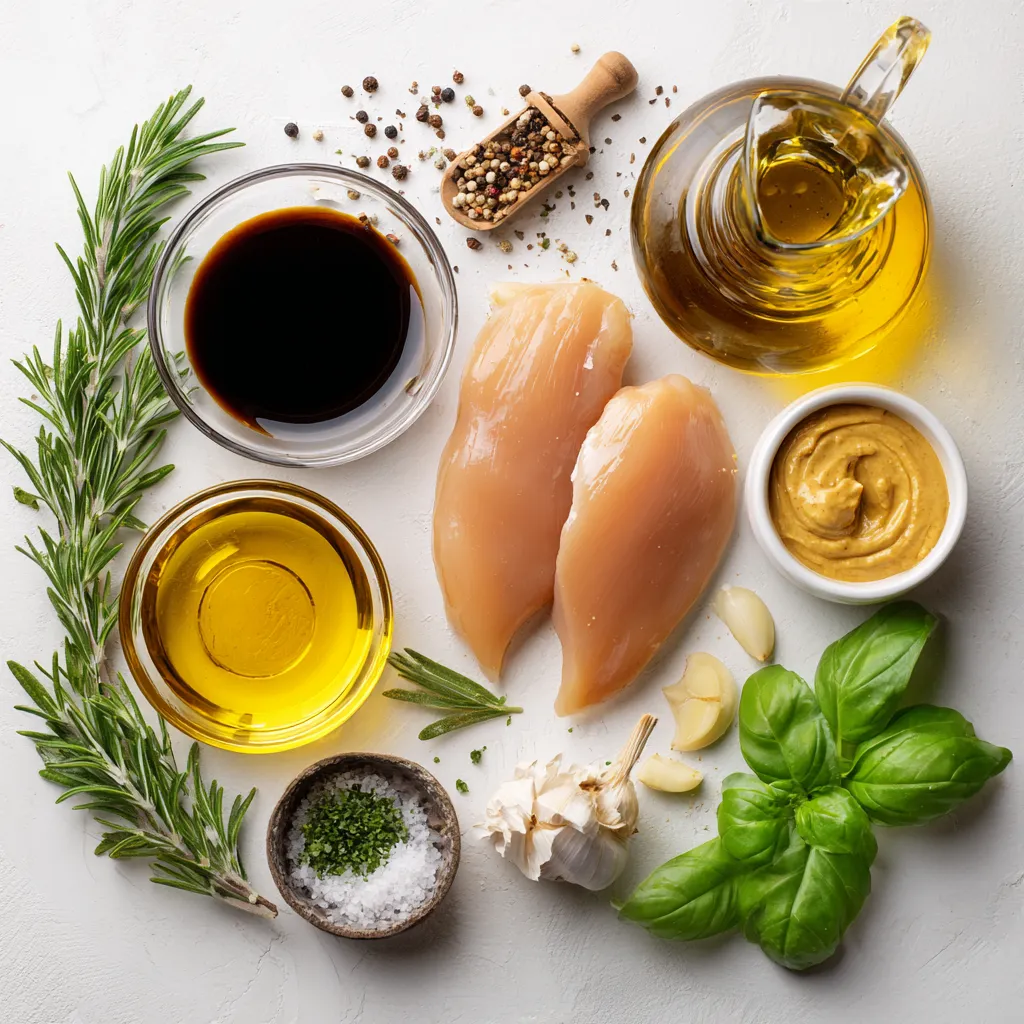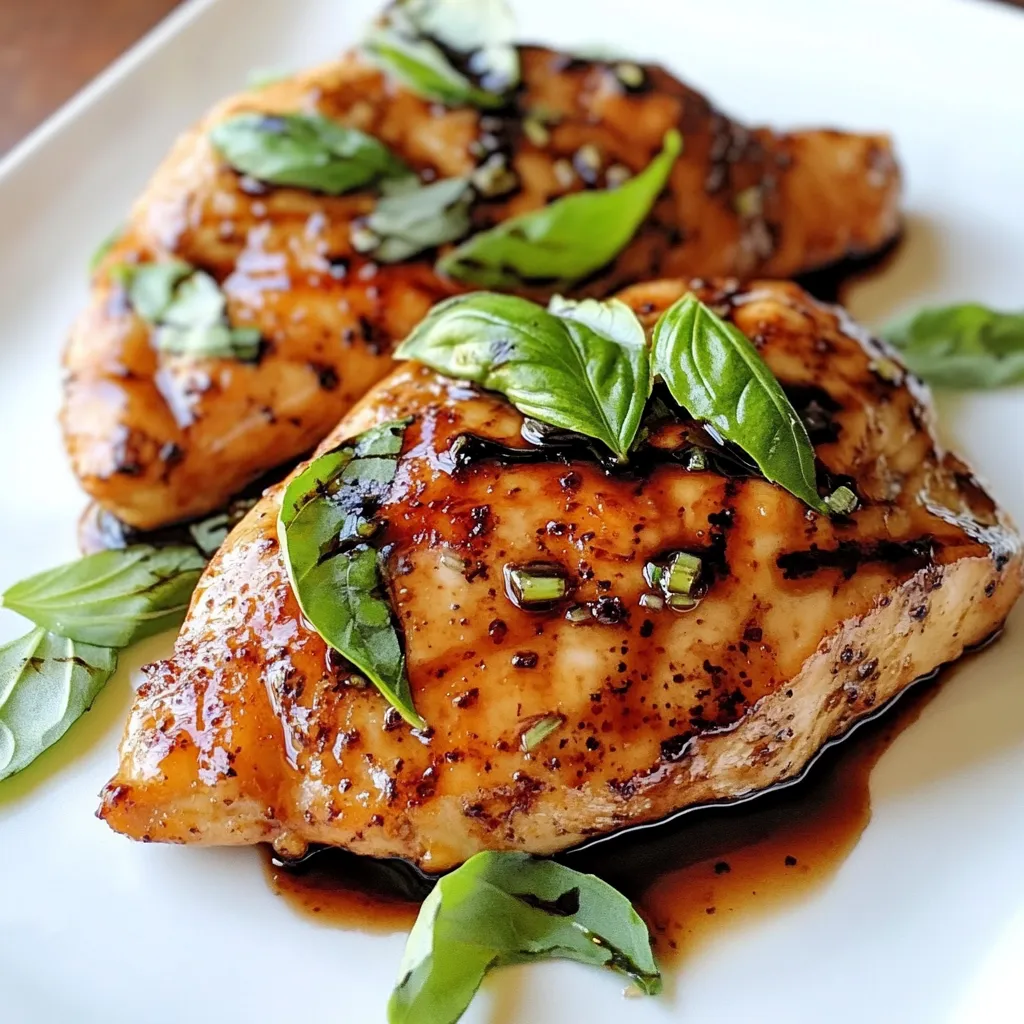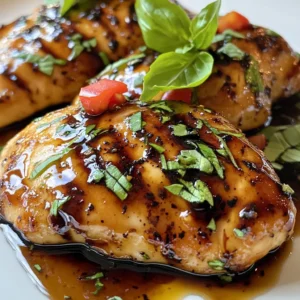WANT TO SAVE THIS RECIPE?
Are you ready to take your dinner to a whole new level? Balsamic Glazed Chicken is a dish packed with rich flavors and easy steps. In this guide, I’ll walk you through simple ingredients, expert cooking tips, and tasty variations. Whether you’re a seasoned chef or just starting out, this recipe promises to impress. Join me on this flavorful journey and discover how to make your meals irresistible!

Why I Love This Recipe
- Easy to Make: This recipe requires minimal ingredients and steps, making it perfect for busy weeknights.
- Flavor Explosion: The combination of balsamic vinegar, honey, and garlic creates a rich and delicious glaze that elevates the chicken.
- Healthy Option: Using boneless, skinless chicken breasts keeps the dish light and nutritious without sacrificing taste.
- Beautiful Presentation: The garnish of fresh basil adds a pop of color, making this dish as visually appealing as it is tasty.
Ingredients
Complete Ingredients List
– 4 boneless, skinless chicken breasts
– 1 cup balsamic vinegar
– 1/4 cup honey
– 2 tablespoons Dijon mustard
– 2 tablespoons olive oil
– 2 cloves garlic, minced
– Salt and pepper to taste
– 1 teaspoon fresh rosemary, chopped (or 1/2 teaspoon dried)
– Fresh basil leaves for garnish
To make balsamic glazed chicken, start with the chicken breasts. Choose fresh, boneless, and skinless options for the best taste and texture. They cook evenly and stay juicy.
Next, balsamic vinegar is key. It adds a deep, sweet tang that brings life to the dish. Honey balances the vinegar’s sharpness, giving a rich flavor. Dijon mustard brings a hint of spice and depth.
Don’t forget your garlic! Minced garlic adds a warm, savory note. Fresh rosemary rounds out the flavor with its earthy scent. Use fresh if you can, but dried works too.
Lastly, olive oil adds richness and helps with cooking. Season with salt and pepper to boost all the flavors. For garnish, fresh basil leaves add color and a burst of freshness.
This simple list of ingredients brings together bold flavors to create an unforgettable meal.

Step-by-Step Instructions
Preparing the Balsamic Glaze
To start, grab a small saucepan. In it, mix one cup of balsamic vinegar, a quarter cup of honey, two tablespoons of Dijon mustard, and two minced cloves of garlic. Stir this well, then heat it on medium. You want to bring it to a gentle simmer. Simmering is key because it helps the glaze thicken. After about 10 to 15 minutes, you will notice it reducing into a rich sauce. When it looks shiny and coats a spoon, it is ready. Remove it from the heat and let it cool slightly.
Preparing the Chicken
While the glaze cools, take four boneless, skinless chicken breasts. Season both sides with salt and pepper. This step adds a lot of flavor. Next, heat two tablespoons of olive oil in a large skillet over medium-high heat. Make sure the oil is hot before adding the chicken. This helps create a beautiful golden brown crust. Place the chicken breasts in the skillet, leaving some space between them.
Cooking the Chicken
Cook the chicken for about 6 to 7 minutes on one side. When it is golden brown, flip the chicken over. Now, pour half of the balsamic glaze over the top. Cook for another 6 to 7 minutes. To know if the chicken is done, use a meat thermometer. The inside must reach 165°F (75°C) for safety. Once cooked, remove the chicken from the skillet. Let it rest for a few minutes. Drizzle the remaining glaze over the chicken before serving. This adds extra flavor and shine.
Tips & Tricks
Achieving the Perfect Glaze
To know if your balsamic glaze is ready, look for a thick, syrupy texture. It should coat the back of a spoon. When you taste it, the flavor should be sweet and tangy. You can enhance the glaze by adding fresh herbs. Rosemary or thyme works great. A pinch of salt can also balance the sweetness.
Cooking Techniques
Use a heavy skillet, like cast iron, for even heat. This helps the chicken cook perfectly. Start at medium-high heat to get a nice sear. Once you flip the chicken, lower the heat to medium. This keeps it juicy and tender.
Serving Suggestions
For sides, serve with roasted vegetables or a fresh salad. Quinoa or rice also pairs well. For plating, place the chicken in the center of the plate. Drizzle with extra glaze and add fresh basil on top. This makes your dish look stunning and appetizing.
Pro Tips
- Marinate for More Flavor: For an even richer taste, marinate the chicken in the balsamic mixture for at least 1 hour or overnight in the refrigerator.
- Use Fresh Herbs: Fresh rosemary and basil provide a vibrant flavor profile. If using dried herbs, remember that their flavor is more concentrated, so use less.
- Check Temperature: Ensure the chicken is fully cooked by checking that it reaches an internal temperature of 165°F (75°C) using a meat thermometer.
- Serve with Sides: This dish pairs wonderfully with roasted vegetables, a fresh salad, or creamy mashed potatoes for a complete meal.

Variations
Ingredient Swaps
You can swap honey for maple syrup or agave nectar. Both options add sweetness. If you want a tangy kick, use apple cider vinegar instead of balsamic. For Dijon mustard, try yellow mustard or stone-ground mustard. Each brings a unique taste.
Herbs can change the dish too. Instead of rosemary, use thyme or oregano. Fresh herbs often add bright flavors. Dried herbs work well too, but use less. They are stronger than fresh herbs.
Cooking Methods
Grilling the chicken gives it a smoky flavor. It’s fun and great for summer. Just brush the glaze on while grilling. This keeps the chicken juicy and tasty.
Pan-searing is easy and quick. You get a nice brown crust. Use a heavy skillet for best results.
If you prefer slow cooking, it works too. Just add the chicken and glaze to the slow cooker. Cook on low for 6-8 hours. The chicken becomes tender and full of flavor.
You can also bake the chicken in the oven. Place it in a dish and pour the glaze over. Bake at 375°F for 25-30 minutes. This method keeps the chicken moist.
Dietary Adjustments
For gluten-free options, check labels on the balsamic vinegar. Most are safe, but some may contain gluten.
To make it low-carb, skip the honey. Use a sugar substitute like erythritol. This keeps the sweetness without the carbs.
If you follow a paleo diet, you may use coconut aminos instead of balsamic vinegar. This keeps the essence while fitting your needs.
Always adjust recipes to fit your diet. Cooking should be fun and flexible!
Storage Info
Refrigeration Tips
Store your balsamic glazed chicken in an airtight container. This keeps it fresh. It will last in the fridge for about 3 to 4 days. Make sure to let it cool before sealing. This avoids steam buildup, which can make it soggy.
Freezing Guidelines
To freeze your balsamic glazed chicken, wrap it tightly in plastic wrap. Then, place it in a freezer-safe bag. This helps prevent freezer burn. It can stay in the freezer for up to 3 months. When you’re ready to eat, thaw it in the fridge overnight. For reheating, place it in a skillet over low heat. This keeps it juicy and full of flavor.
Meal Prep Ideas
You can easily add balsamic glazed chicken to your weekly meal plan. Cook a batch on Sunday. Portion it out for lunches or dinners. It works great in salads, wraps, or with rice. You can also make the glaze ahead of time. Store it in the fridge for up to a week. This makes cooking easy on busy nights.
FAQs
What is balsamic glazed chicken?
Balsamic glazed chicken is a savory dish that blends chicken with a sweet-tangy sauce. The dish comes from Italy, where balsamic vinegar has deep roots. The glaze combines balsamic vinegar, honey, and Dijon mustard for a rich flavor. This mix gives the chicken a shiny, sticky coating that is hard to resist. People love this dish for its balance of sweet and savory notes.
How do you tell when chicken is cooked through?
To check if chicken is fully cooked, use a meat thermometer. The safe internal temperature is 165°F (75°C). You can also look for clear juices when you cut into the chicken. If the juices run clear, it’s ready to eat. The chicken should feel firm to the touch, not soft. These cues help ensure your chicken is safe and tasty.
Can you use other meats for this recipe?
Yes, you can use other meats with balsamic glaze. Pork tenderloin is a great option. It absorbs flavors well and cooks nicely. You can also try chicken thighs or turkey breasts. Each meat will give a unique taste but still pair well with the glaze. Just remember to adjust cooking times for each type of meat.
How can I make this recipe healthier?
To make balsamic glazed chicken healthier, try these tips. Use less honey to cut down on sugar. You can also swap boneless chicken breasts for skinless chicken thighs. Another option is to use low-sodium soy sauce instead of salt. Adding more herbs like parsley or thyme can boost flavor without extra calories. These changes keep the dish tasty and light.
Balsamic glazed chicken is a delicious dish that’s easy to make. We covered key ingredients, step-by-step cooking methods, and helpful tips. You can customize it with different flavors or diets. Proper storage ensures your leftovers stay fresh. Cooking this dish lets you impress family and friends. Enjoy tasty meals with simple planning and preparation. Make it your own, and don’t hesitate to experiment. Your kitchen adventures can thrive with this flavorful recip
Balsamic Bliss Chicken
A delicious chicken dish glazed with a sweet and tangy balsamic reduction.
Prep Time 10 minutes mins
Cook Time 25 minutes mins
Total Time 35 minutes mins
Course Main Course
Cuisine American
Servings 4
Calories 300 kcal
- 4 pieces boneless, skinless chicken breasts
- 1 cup balsamic vinegar
- 1 quarter cup honey
- 2 tablespoons Dijon mustard
- 2 tablespoons olive oil
- 2 cloves garlic, minced
- 1 teaspoon fresh rosemary, chopped
- 1 pinch salt and pepper to taste
- 1 handful fresh basil leaves for garnish
In a small saucepan, combine balsamic vinegar, honey, Dijon mustard, minced garlic, and ground rosemary. Bring to a simmer over medium heat, stirring occasionally until it reduces and thickens (about 10-15 minutes). Remove from heat and let it cool slightly.
While the balsamic glaze is cooling, season the chicken breasts on both sides with salt and pepper.
In a large skillet, heat olive oil over medium-high heat. Add the chicken breasts to the skillet and cook for about 6-7 minutes on one side until golden brown.
Turn the chicken breasts over and pour half of the balsamic glaze over them. Cook for an additional 6-7 minutes, or until the chicken is cooked through and the internal temperature reaches 165°F (75°C).
Once cooked, remove the chicken from the skillet and let it rest for a few minutes. Drizzle the remaining balsamic glaze over the chicken before serving.
Garnish with fresh basil leaves for an extra touch of flavor and color.
Let the chicken rest before serving for better flavor.
Keyword balsamic, chicken, dinner, glaze
WANT TO SAVE THIS RECIPE?





